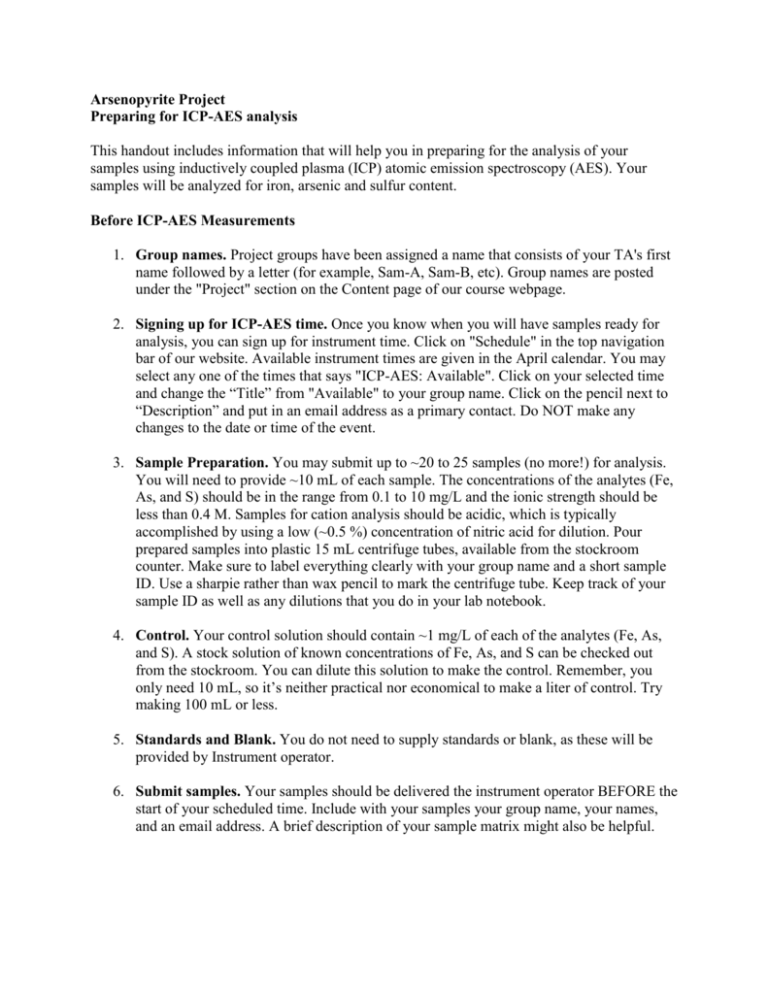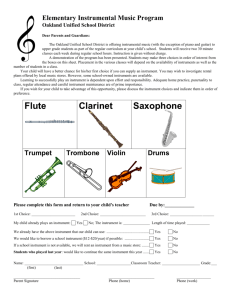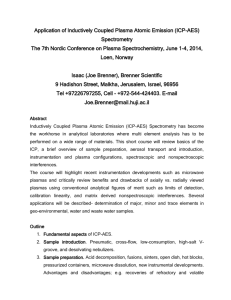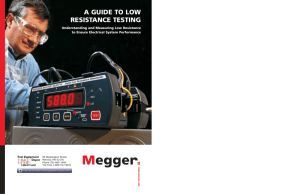Word - ASDL Community
advertisement

Arsenopyrite Project Preparing for ICP-AES analysis This handout includes information that will help you in preparing for the analysis of your samples using inductively coupled plasma (ICP) atomic emission spectroscopy (AES). Your samples will be analyzed for iron, arsenic and sulfur content. Before ICP-AES Measurements 1. Group names. Project groups have been assigned a name that consists of your TA's first name followed by a letter (for example, Sam-A, Sam-B, etc). Group names are posted under the "Project" section on the Content page of our course webpage. 2. Signing up for ICP-AES time. Once you know when you will have samples ready for analysis, you can sign up for instrument time. Click on "Schedule" in the top navigation bar of our website. Available instrument times are given in the April calendar. You may select any one of the times that says "ICP-AES: Available". Click on your selected time and change the “Title” from "Available" to your group name. Click on the pencil next to “Description” and put in an email address as a primary contact. Do NOT make any changes to the date or time of the event. 3. Sample Preparation. You may submit up to ~20 to 25 samples (no more!) for analysis. You will need to provide ~10 mL of each sample. The concentrations of the analytes (Fe, As, and S) should be in the range from 0.1 to 10 mg/L and the ionic strength should be less than 0.4 M. Samples for cation analysis should be acidic, which is typically accomplished by using a low (~0.5 %) concentration of nitric acid for dilution. Pour prepared samples into plastic 15 mL centrifuge tubes, available from the stockroom counter. Make sure to label everything clearly with your group name and a short sample ID. Use a sharpie rather than wax pencil to mark the centrifuge tube. Keep track of your sample ID as well as any dilutions that you do in your lab notebook. 4. Control. Your control solution should contain ~1 mg/L of each of the analytes (Fe, As, and S). A stock solution of known concentrations of Fe, As, and S can be checked out from the stockroom. You can dilute this solution to make the control. Remember, you only need 10 mL, so it’s neither practical nor economical to make a liter of control. Try making 100 mL or less. 5. Standards and Blank. You do not need to supply standards or blank, as these will be provided by Instrument operator. 6. Submit samples. Your samples should be delivered the instrument operator BEFORE the start of your scheduled time. Include with your samples your group name, your names, and an email address. A brief description of your sample matrix might also be helpful. During ICP-AES Measurements You are not required to be present while your samples are being run. However, if you are interested and your schedule permits, your group (some or all of you) is welcome to meet with the instrument operator during your scheduled instrument time. The instrument operator can introduce you to the instrument and you can get immediate feedback on how the analysis is going. If you would like to do this, you should email the instrument operator to let her know what time you can come. It is best if everyone from your group could come at the same time. After ICP-AES Measurements 1. Raw data. The raw data from the measurements will be uploaded to a folder on the course webpage. The filename will be your group name. The raw data will include spectra and peak intensities from your samples, your control, and the standards. Your samples will be identified by the IDs you provide on the centrifuge tubes. 2. Data analysis. You will need to prepare calibration plots using the raw data from the standards. You can use this plot to determine the concentrations of dissolved iron, arsenic and sulfur in your samples. Remember that the results will yield the concentrations of the prepared samples submitted to Instrument operator. For your final analysis, you will need to correct for any dilutions that you did. 3. Disposal of samples. Your samples and the control will be disposed of in a heavy metal waste carboy unless you direct the instrument operator to save them. When you are all done with your experiments, you should decant your solutions and put the liquid in the heavy metal waste carboy in your lab. Any remaining arsenopyrite should be placed in the solid waste container that will be labeled for this purpose in the lab. The mineral will be recovered and reused. Any used but empty plastic centrifuge tubes can be discarded in the regular trash.









